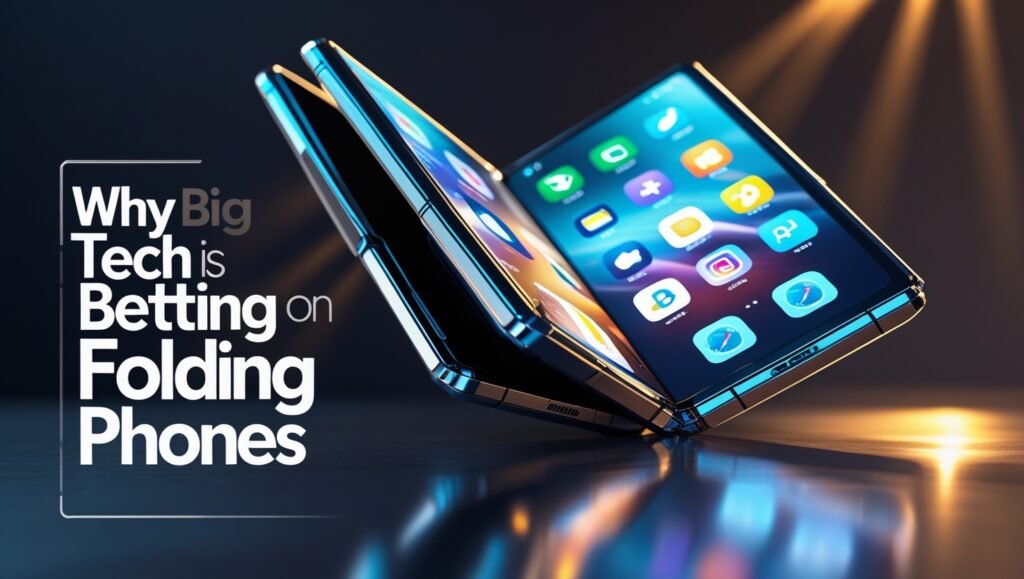
For years, the smartphone market felt stagnant, dominated by a familiar, flat rectangular slab. Then came the whispers, then the prototypes, and finally, the reality of the folding phone. These devices, which transform from a compact handset to a tablet-sized screen, have captured the imagination of consumers and the intense focus of tech giants. So why are major players like Samsung, Google, and even Apple’s rumored plans so heavily invested in this new technology? It’s not just a gimmick; it’s a strategic move to redefine mobile computing, unlock new revenue streams, and regain the sense of wonder that has been missing from the industry. Big Tech sees folding phones as the key to a new era of innovation and a way to break free from the traditional smartphone mold.
The Quest for Innovation and Market Dominance:
In a highly saturated market, standing out is a matter of survival. The flat-screen smartphone, while a technological marvel, has reached a point of diminishing returns. Incremental upgrades to cameras or processors no longer generate the same level of excitement as they once did. Folding phones, however, represent a genuine leap forward. They are a visible statement of a company’s commitment to pushing the boundaries of what is possible. By pioneering this new form factor, a company can position itself as an industry leader, attracting early adopters and tech enthusiasts who are always on the hunt for the next big thing.
- Samsung’s First-Mover Advantage: Samsung has been the undisputed leader in the foldable space, having released multiple generations of its Galaxy Z Fold and Z Flip series. This first-mover advantage has allowed them to dominate the market and establish a strong brand identity as the creator of the foldable category. This is an immense strategic win, as they’ve built customer loyalty and a large user base that is deeply invested in their ecosystem.
- Google’s Strategic Entry: Google’s Pixel Fold isn’t just a device; it’s a signal to developers. By creating its own foldable phone, Google is not only competing in the hardware space but is also actively encouraging app developers to optimize their software for the unique form factor. This software integration is critical to the long-term success of the category, as a phone is only as good as the apps that run on it.
- Apple’s Potential Impact: While Apple has yet to release a foldable device, the constant rumors of a future “foldable iPhone” are enough to send shockwaves through the industry. When a brand with the cultural weight of Apple enters a new market, it often legitimizes the category for the mainstream. An Apple foldable could be the catalyst that drives widespread adoption and truly makes folding phones the new norm.
A New Frontier for Productivity and Multitasking:
The most compelling argument for folding phones isn’t about their futuristic look; it’s about the practical utility they offer. They are the perfect blend of a smartphone and a tablet, providing a large, expansive screen for work and play, without the bulk of carrying two separate devices. This hybrid nature unlocks a new frontier for productivity and multitasking that is simply not possible on a traditional phone.
- Split-Screen Multitasking: Imagine drafting an email while simultaneously referencing a document, or watching a video on one side of the screen while chatting with a friend on the other. The large screen real estate of a foldable phone makes split-screen multitasking not just a feature, but a comfortable and intuitive way of working. It allows users to be more efficient and get more done on the go, bridging the gap between mobile and desktop computing.
- A Content Creator’s Dream: For photographers, filmmakers, and digital artists, the larger screen is a game-changer. It provides a more immersive canvas for viewing and editing media. The ability to use the phone in a “tent” or “laptop” mode also opens up new possibilities for hands-free video calls, watching movies, or taking unique photos and videos. This versatility transforms the device from a simple consumption tool into a powerful creation engine.
- Tablet Consolidation: For many users, a folding phone could eventually replace the need for a separate tablet. The convenience of having a single device that serves multiple purposes is a powerful selling point. This device consolidation is a huge incentive for consumers who are tired of managing multiple gadgets and for businesses looking to simplify their hardware distribution.
Overcoming Challenges and Driving Future Growth:
Despite their immense potential, folding phones still face significant hurdles. The high price tag, concerns about durability, and the visible crease on the screen have been major points of hesitation for mainstream consumers. However, these challenges are precisely what big tech companies are pouring resources into solving.
- Innovating Display and Hinge Technology: Manufacturers are constantly refining the complex hinge mechanisms and developing more durable, flexible display materials. Innovations like Ultra-Thin Glass (UTG) are making screens more scratch-resistant and the crease less noticeable. Each new generation of folding phones brings us closer to a future where these devices are as robust and reliable as their rigid counterparts.
- Lowering Manufacturing Costs: The initial high cost of production is slowly coming down as manufacturing processes become more efficient. As more brands enter the market and economies of scale take effect, the prices of foldable phones are expected to drop, making them more accessible to a wider audience.
- Cultivating a Developer Ecosystem: The success of the foldable form factor hinges on a vibrant and optimized software ecosystem. Companies are working closely with developers to ensure apps seamlessly adapt to the different screen sizes and orientations. This collaboration is crucial for providing a fluid and satisfying user experience, and it’s a major reason why companies like Google are leading the charge.
Big tech is not just gambling on a trend; they are investing in the very foundation of the next generation of mobile computing. The folding phone is an opportunity to revitalize a stagnant market, create new business models, and deliver an experience that truly redefines how we interact with our devices. It’s a bet on innovation, and it’s a bet they are determined to win.
Conclusion:
The fervor around folding phones isn’t just a passing fad; it’s a strategic investment by major tech companies to lead the next wave of mobile innovation. By solving key challenges and leveraging the unique benefits of the form factor, these giants are poised to unlock new levels of productivity and redefine the very concept of a smartphone. The future of mobile is unfolding, and big tech is all in.
FAQs:
1. What is the main benefit of a folding phone?
The main benefit is having a large, tablet-sized screen for multitasking and media consumption in a device that can fold to a pocketable size.
2. Are folding phones more fragile than regular phones?
Early models were, but new advancements in materials and hinge design have made them significantly more durable.
3. Why are folding phones so expensive?
The high cost is due to the complex and expensive technology of the flexible display and hinge mechanism.
4. Which companies are making folding phones?
Samsung is the market leader, with other companies like Google, Huawei, and Motorola also producing popular foldable devices.
5. Will all phones eventually be foldable?
While they are gaining popularity, it’s more likely that folding phones will exist as a premium option alongside traditional smartphones.
6. Do app developers support folding phones?
Yes, companies are actively encouraging developers to optimize their apps for the unique screen sizes and multitasking capabilities of folding phones.
